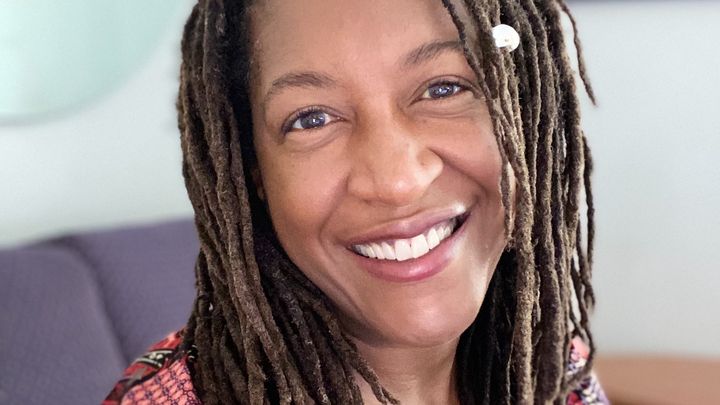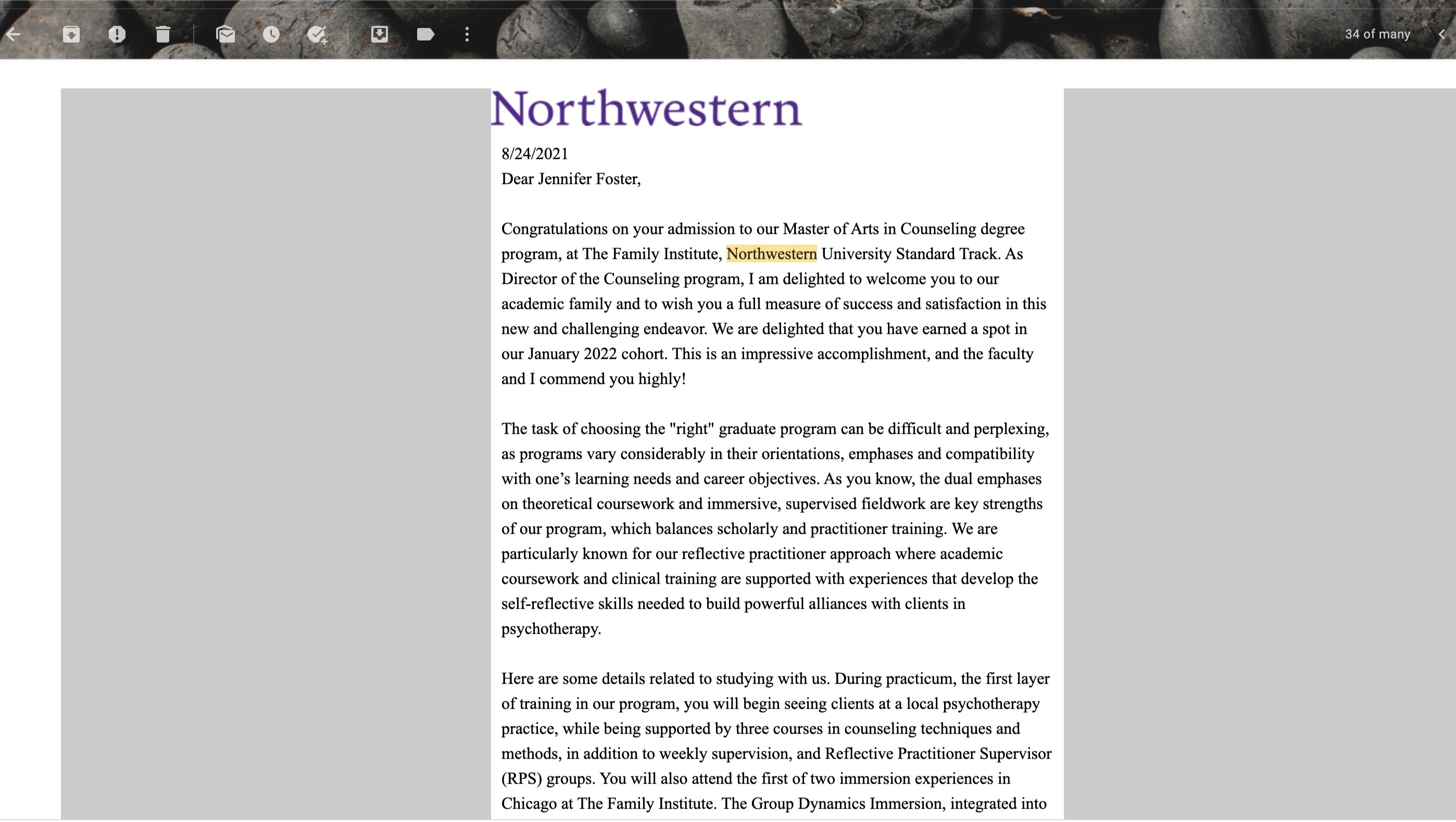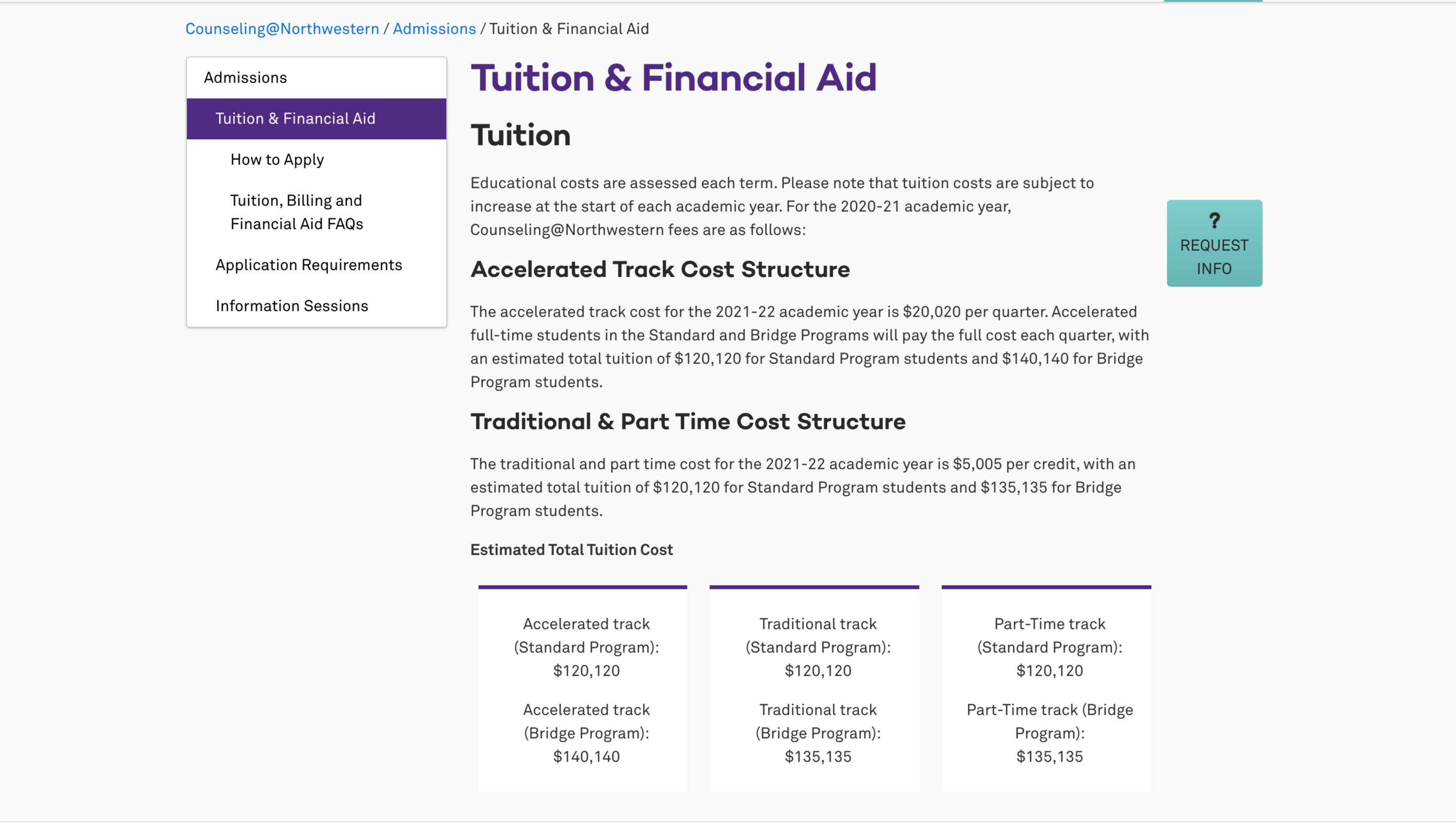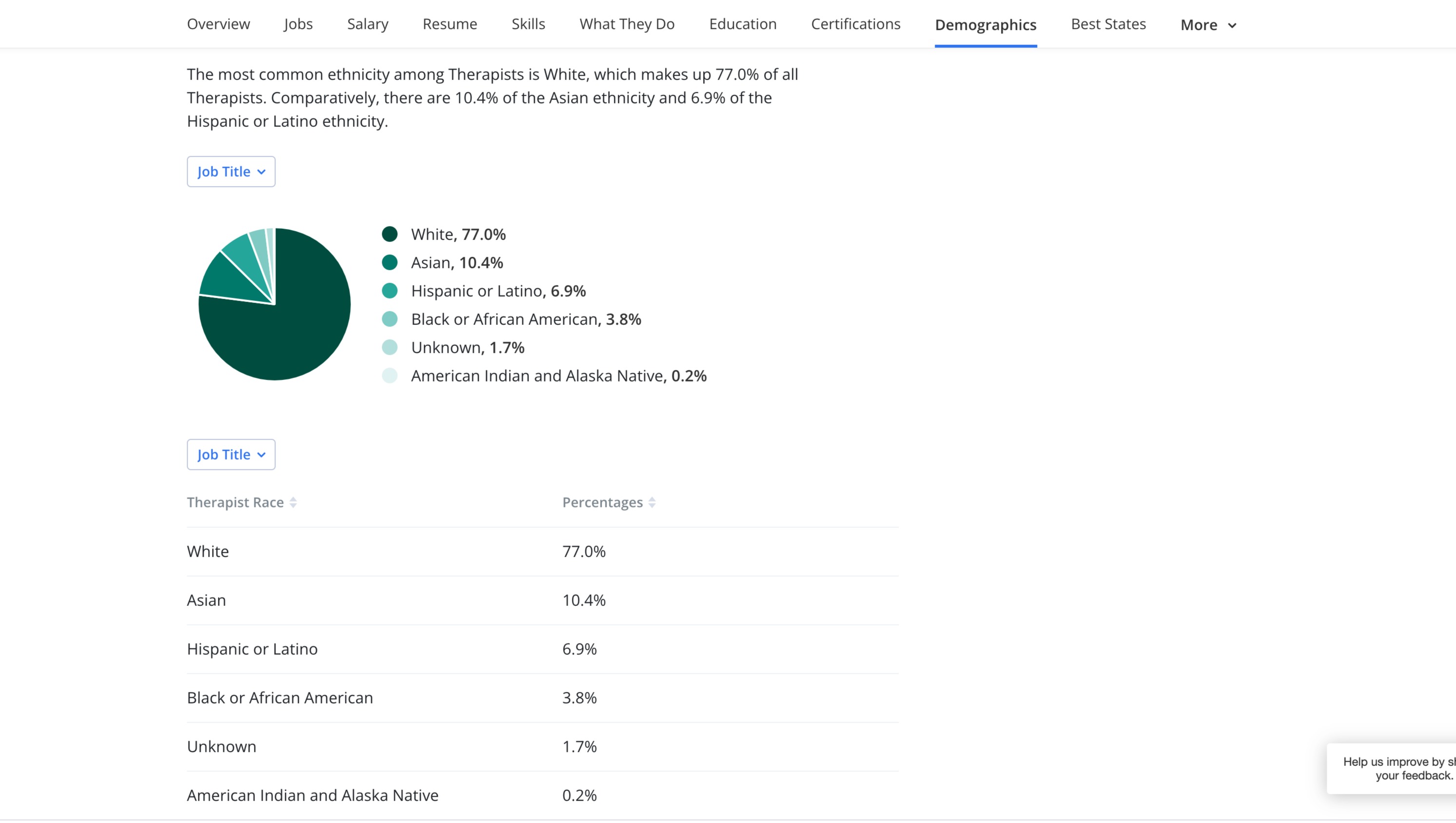
Help Jen Make it to Northwestern University!
Donation protected
Hello everyone!
Late this summer of 2021, I was notified of being accepted to Northwestern University!! I worked very hard to get here, and I am over the moon with excitement. My journey started in the fall of 2020 when my first year of graduate school was spent at Pepperdine University where I excelled in their Master's in Clinical Counseling program (with a 4.0 GPA). Unfortunately, Pepperdine's program does not support the state of Hawaii, so with much disappointment, I had to exit that program. I decided to shoot for the stars and apply for Northwestern's prestigious graduate program in Clinical Counseling. After a rigorous application process that included multiple essays and interviews, I am honored to have been chosen to attend a program that is in the top ten of universities in the United States.
After a considerable amount of hard work, I am now in danger of not being able to start at Northwestern in January of 2022, due to a lack of financial aid. I was awarded $5,000 per quarter of financial aid, as well as a $10,000 scholarship that will be spread evenly across nine quarters. This leaves me with a deficit of $10,000 per quarter, or approximately $40,000 per year that I need to generate in order to attend graduate school.
Late this summer of 2021, I was notified of being accepted to Northwestern University!! I worked very hard to get here, and I am over the moon with excitement. My journey started in the fall of 2020 when my first year of graduate school was spent at Pepperdine University where I excelled in their Master's in Clinical Counseling program (with a 4.0 GPA). Unfortunately, Pepperdine's program does not support the state of Hawaii, so with much disappointment, I had to exit that program. I decided to shoot for the stars and apply for Northwestern's prestigious graduate program in Clinical Counseling. After a rigorous application process that included multiple essays and interviews, I am honored to have been chosen to attend a program that is in the top ten of universities in the United States.
After a considerable amount of hard work, I am now in danger of not being able to start at Northwestern in January of 2022, due to a lack of financial aid. I was awarded $5,000 per quarter of financial aid, as well as a $10,000 scholarship that will be spread evenly across nine quarters. This leaves me with a deficit of $10,000 per quarter, or approximately $40,000 per year that I need to generate in order to attend graduate school.

It took a tremendous amount of courage for me to go "back to school" at midlife (I'm 48 years young!), but here I am. I am so grateful for the opportunity to be selected to attend such a prestigious school.
Below is a snapshot of Northwestern University's cost of tuition for the entire Master's in Clinical Counseling program. As of the fall of 2021, the cost of tuition is $120,120.
Below is a snapshot of Northwestern University's cost of tuition for the entire Master's in Clinical Counseling program. As of the fall of 2021, the cost of tuition is $120,120.

A little bit about me:
My story begins in a small town in Missouri, outside of Kansas City, where I was raised. I was one of about five African-American children (in a class of 500+ students) in an all-white school in the suburbs. My parents were hard-working middle-class parents with the strong work ethic that Midwesterners are known for. They worked tirelessly so I could be raised in a safe environment and receive the best education possible. I was the second person in the family to receive a college degree, and with your help, I will be one of very few in my immediate family to receive a master's degree.
My story begins in a small town in Missouri, outside of Kansas City, where I was raised. I was one of about five African-American children (in a class of 500+ students) in an all-white school in the suburbs. My parents were hard-working middle-class parents with the strong work ethic that Midwesterners are known for. They worked tirelessly so I could be raised in a safe environment and receive the best education possible. I was the second person in the family to receive a college degree, and with your help, I will be one of very few in my immediate family to receive a master's degree.
I believe it is my life purpose to help people heal. In these challenging times, so much of the population is suffering from mental health issues. There are not enough licensed mental health practitioners to serve the overwhelming numbers of those who are in dire need of help. For the underserved and underrepresented populations in the country, the numbers are dismal.
- There are over 198,811 Therapists currently employed in the United States.
- 77% of therapists are White
- 3.8% of therapists are African-American
- There are over 198,811 Therapists currently employed in the United States.
- 77% of therapists are White
- 3.8% of therapists are African-American

According to studies conducted by organizations like Substance Abuse and Mental Health Services Administration (SAMHSA), Centers for Disease Control and Prevention (CDC), and the U.S. Department of Justice:
- 1 in 5 U.S. adults experience mental illness each year (51.5 million people)
- 1 in 20 U.S. adults experience serious mental illness each year (13.1 million people)
- 1 in 6 U.S. youth aged 6-17 experience a mental health disorder each year (7.7 million people)
- 50% of all lifetime mental illness begins by age 14, and 75% by age 24
- Suicide is the 2nd leading cause of death among people aged 10-34
Annual prevalence of mental illness among U.S. adults, by demographic group:
Non-Hispanic Asian: 14.4%
Non-Hispanic white: 22.2%
Non-Hispanic black or African-American: 17.3%
Non-Hispanic American Indian or Alaska Native: 18.7%
Non-Hispanic mixed/multiracial: 31.7%
Non-Hispanic Native Hawaiian or Other Pacific Islander: 16.6%
Hispanic or Latino: 18.0%
Lesbian, Gay or Bisexual: 44.1%
_________
The Ripple Effect Of Mental Illness*
- People with depression have a 40% higher risk of developing cardiovascular and metabolic diseases than the general population. People with serious mental illness are nearly twice as likely to develop these conditions.
- 18.4% of U.S. adults with mental illness also experienced a substance use disorder in 2019 (9.5 million individuals)
- High school students with significant symptoms of depression are more than twice as likely to drop out compared to their peers
- Students aged 6-17 with mental, emotional, or behavioral concerns are 3x more likely to repeat a grade.
- Depression is a leading cause of disability worldwide
The Negative Financial and Social Impact of Mental Illness*
- The rate of unemployment is higher among U.S. adults who have a mental illness (5.8%) compared to those who do not (3.6%)
- Mental illness and substance use disorders are involved in 1 out of every 8 emergency department visits by a U.S. adult (estimated 12 million visits)
- About 2 million times each year, people with serious mental illness are booked into jails.
- 20.5% of people experiencing homelessness in the U.S. have a serious mental health condition
- 37% of adults incarcerated in the state and federal prison system have a diagnosed mental illness
- 70.4% of youth in the juvenile justice system have a diagnosed mental illness
- 41% of Veteran’s Health Administration patients have a diagnosed mental illness or substance use disorder
- Depression and anxiety disorders cost the global economy $1 trillion in lost productivity each year
*Source: NAMI - National Alliance on Mental Illness
-----
It is my mission and my life's purpose to be of service to society as a professional Mental Health Counselor, in service to the BIPOC community and beyond. I want to do everything I can to make a significant impact in helping shift the negative stigma of mental health and help as many people as possible achieve mental well-being. I believe we are at a crucial tipping point and shortage of mental health professionals. The need for professionally trained/licensed mental-health professionals is the highest it has ever been. Mental Illness has a physical, social, and financial impact on our society. As a mental health practitioner, I consider it my job to raise public awareness, promote stigma-busting, and advocate for better health care.
Northwestern University is one of the top schools in the country, and only 5.3% of the school population is Black or African-American. The inequality of race present in the top (and therefore, most expensive) universities in the country is astounding. With an average tuition of $120,000+, the average family (regardless of race) cannot afford to send their family members to the top-tier universities of this country. Those who do make it, are drowning in student debt.
I was accepted to Northwestern University due to hard work, ambition, and merit. Please help me fight for the right to have high-quality education that is often exclusively accessible for only a small portion of this country's population.
____________
All donations will be directly deposited into my Northwestern University student account, and I will provide proof of this as the donations come in.
Total Costs:
Tuition: $120,120
Books: $5,552
Health Insurance: $8,772
____________
Any donations received in excess of my goal amount will be put towards creating a scholarship fund for those who want to pursue a master's in counseling or social work! Thank you for helping me realize my dreams!
~ Future Therapist, Jennifer Foster
Organizer
Jennifer Foster
Organizer
Peoria, AZ